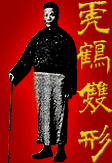|
They say that if you wield a skilful pen, you must wield arms as well, because arms are a support for a pen. Since my young years till now I have been learning from
Masters during fifty years. Fortunately, I earned the love of my tutors who passed me the
Shaolin
Mastery. I think that I have acquired that
Mastery far from perfection. As a token of my thankfulness to my tutors, I also passed the
Technique and the
Mastery to my disciples during a few decades. I do not think that I am a patient and skilful tutor, because we suffered a lot of changes in our lives.
The
Pugilistic Art is easy to learn, but it is difficult to gain perfection in it. First of all, it is necessary to know
rules and
laws, as well as
norms and
criteria and then add
Force to them. In that case you improve your
innate nature and can freely and easily move in all directions, attack and avoid enemy's attacks. One must perceive the secrets of
"The Four
Essences-Dao", methods of
"Five
Gates-Men", images of
"Eight Directions-Mian" and ways of
Life and
Death.
What are
"Four
Dao"? Those are heart, eyes, arms, and legs.
Dao of a heart is a realized behavior,
Dao of eyes is light and order,
Dao of arms is easiness in attack and clutch,
Dao of legs is quickness in a fight.
"Five
Men" is
top,
middle,
bottom,
left and
right side. The
top has
"Seven Openings-Qiao: eyes, ears, nostrils and mouth, the
middle has a heart and a breast, the
bottom has groin, the left side has the
left arm and the left leg, the right side has the
right arm and the right leg. If a man deeply perceived and understood it, he is a master of the situation.
Furthermore, you must see the situation on four sides -
east,
west,
south, and
north. It is necessary to take a commanding position, to find out strong and weak points in your enemy, to direct your attacks towards his weak points, to strive for life and to avoid death. You should
"look into the
distance", but you should not lose sight of the situation around you.
If the enemy makes a false lunge (feint), it is necessary to react seriously; if the enemy attacks in all seriousness, you should dodge.
If the enemy is far from you, you should not swing your fists, if he is close to you, you should forestall him. If he attacks at the top (at the upper level), you should react at the top, and if he attacks from below (at the lower level), you should to block up the ways of an attack from below.
It is necessary to observe attentively enemy's movements, foresee the direction of his attack. You should perfectly comprehend the essence of an
attack and a
retreat, methods of
"rise" and
"sink".
Train persistently and tirelessly every
day; there is a saying
"Mastery is born in hard
training". Thousand of types of
Fighting Arts come to one criterion, ten thousand methods come to the same essence.
In the great antiquity
Hua Tuo* told
Wu Pu** that if the body often moves, food is digested more easily; movement also promote the circulation of blood and energy
Chi.
"Lu
Lan"*** says the same:
"The running water is fresh, a worm can not live in a door
hinge". Those words express the essence of movement as a base to preserve health. The same is with the
Pugilistic
Art: it is not only a means of self-defense, but also a means to improve in health. Therefore, as a rule, those who practise
Fighting Arts are men of strong constitution and good cheer. Undoubtedly,
Fighting Arts cure diseases and prolong one's life, it is of great benefit! I frankly and openly tell scholars of the future about it. As far as we are concerned, we must preserve the
Fighting Arts as an integral element of the national
Cultural
Heritage.
 |
(Lam Sai Wing) |
...............................................................
*Hua Tuo (141? - 208) is a famous physician and a follower of Taoism. He created a complex of "Plays of Five Animals" (WUQINXI) owing which through the imitation of movements of different animals - bear, tiger, deer, monkey, and crane the energy Chi correctly circulates in a human organism and that cause effects of rejuvenation and invigoration.
**Wu Pu is a disciple and a successor to Hua Tuo. He widely used WUQINXI in his medical practice.
***"Lu Lan" is the title of collected works on natural science and philosophy compiled in III century B.C., also known under the title "Lu Shi Chun Qu" ("Springs and Autumns of Lu
Kin").
|
 |

